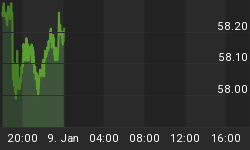I'll start with a quote from Silas Marner, a novel by George Eliot, that is especially apt for the current economic situation and the mass investors' psychology:
The sense of security more frequently springs from habit than from conviction, and for this reason, it often subsists after such a change in the conditions as might have been expected to suggest alarm. The lapse of time during which a given event has not happened is, in this logic of habit, constantly alleged as a reason why the event should never happen, even when the lapse of time is precisely the added condition which makes the event imminent.
In the most recent issue (Week of September 20) of Barron's Financial Weekly's Q&A session, when Sandra Ward asked why his prediction of "financial disaster" still hasn't panned out after two years, the former Capital Research & Management portfolio counselor, David Richards, gave the above quote as the reply. Indeed, gold, silver, and the mining stocks are still down. Both presidential candidates have been more or less ignoring the important issues, in particular, the fiscal issues. And pink, a rosy color psychologically associated with complacency and escapism, is back (just check out your local mall).
In my August 2nd "
I went on to conclude the article by suggesting a "deflation scare" silver play that is based on housing bubble. I wrote:
The housing bubble is becoming a popular topic again. My guess is that somewhere in the near future, there may be a "deflation scare." However, a monetary system central bank with paper fiat money, which is what we have now all over the world, deflation can never occur. Only more and more inflation (please see Ed Bugos' "
Central bank may use this "deflation scare" (from the puncture of housing and mortgage bubbles) to prop the Dollar and suppress silver and gold price. For those who don't have a silver position, this down leg is a good opportunity to build a position. As for those who already own silver and/or silver stocks. This is also a good opportunity for planned addition.
Just last week, both the Fortune ("

To be exact, almost all the price declines occurred within the first six trading days of September. Both the Fortune and the Economist real estate articles hit my local library on Friday the tenth (as indicated by the arrow). I bought some silver around $6.15 spot. (Note that the above chart is futures prices, spot prices are generally slightly lower, though commissions are higher than futures trading.) I hope you took advantage of my August 2nd recommendation and picked up some physical silver.
Although "timing" is an extremely difficult, 33-trillion-dollar1 question, I will take a guess that the puncturing of the real estate bubble maybe the beginning of the end for all manipulation by the banking establishment. Before I go on to explain the reasons, please note that the "timing" is only a guess.
The housing market in general is much more difficult to manipulate. For one thing, there are no "paper" real estate derivatives available. The bullion banks can use futures, options, and OTC derivative contracts to suppress gold and silver prices. The federal reserve can intervene, or at least influence, the bond and stock markets through discount rate management, direct purchase of long bonds, and purchase of stock futures through market agents. The size (in multi-trillion dollar range), complexity (unlike stocks and bonds, real estate properties are not fungible), and lack of paper derivatives are just too many obstacles for the banking establishment to directly or indirectly purchase real estate properties for the purposes of targeting asset prices. Compounding to these obstacles is the evidence of bubbles forming in this sector throughout many countries:
Calculations by The Economist show that home prices are now at record levels in relation to average incomes in America, Australia, Britain, France, Ireland, the Netherlands, New Zealand and Spain; on current trends, Italy will join this group by the end of the year. In other words, houses are more overvalued today than at previous peaks, from which prices typically fell sharply in real terms. Add in China and South Africa, and two-thirds (by economic weight) of the world that we track now has a potential housing bubble. [from "The sun also sets"]
The puncturing of housing bubble may well be the fuse that detonates all other bubbles. The manipulation of all other markets may begin to end with the inability of the global central banking establishment to prop up the real estate market. If this is the case, that is, if my guess is correct, then now may be a good time and possibly the last chance for you to accumulate physical silver or your favorite silver stock(s).
P.S. I had received an e-mail expressing skepticism about my claim that deflation cannot happen under a central bank with fiat money. I will write about why I think monetary deflation is much less likely to occur (at least for now) than monetary inflation in a future article, and how the dynamic relates to the fundamentals of the silver market.
1 World bond market is approximately 33 trillion dollars which, of course, are all based on paper fiat and therefore likely to go into precious metals in the case of hyperinflation or mass default from economic depression.
















